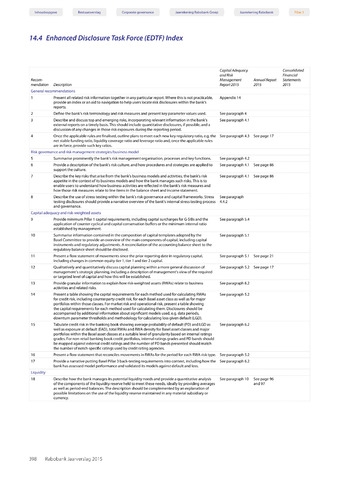14.4 Enhanced Disclosure Task Force (EDTF) Index
Inhoudsopgave Bestuursverslag Corporate governance Jaarrekening Rabobank Groep Jaarrekening Rabobank
Recom
mendation
Description
Capital Adequacy
and Risk
Management
Report 2015
Consolidated
Financial
Annual Report Statements
2015 2015
General recommendations
1
Present all related risk information together in any particular report. Where this is not practicable,
provide an index or an aid to navigation to help users locate risk disclosures within the bank's
reports.
Appendix 14
2
Define the bank's risk terminology and risk measures and present key parameter values used.
See paragraph 4
3
Describe and discuss top and emerging risks, incorporating relevant information in the bank's
external reports on a timely basis. This should include quantitative disclosures, if possible, and a
discussion of any changes in those risk exposures during the reporting period.
See paragraph 4.1
4
Once the applicable rules are finalised, outline plans to meet each new key regulatory ratio, e.g. the
net stable funding ratio, liquidity coverage ratio and leverage ratio and, once the applicable rules
are in force, provide such key ratios.
See paragraph 4.3
See page 17
Risk governance and risk management strategies/business model
5
Summarise prominently the bank's risk management organisation, processes and key functions.
See paragraph 4.2
6
Provide a description of the bank's risk culture, and how procedures and strategies are applied to
support the culture.
See paragraph 4.1
See page 86
7
Describe the key risks that arise from the bank's business models and activities, the bank's risk
appetite in the context of its business models and how the bank manages such risks. This is to
enable users to understand how business activities are reflected in the bank's risk measures and
how those risk measures relate to line items in the balance sheet and income statement.
See paragraph 4.1
See page 86
8
Describe the use of stress testing within the bank's risk governance and capital frameworks. Stress
testing disclosures should provide a narrative overview of the bank's internal stress testing process
and governance.
See paragraph
4.4.2
Capital adequacy and risk-weighted assets
9
Provide minimum Pillar 1 capital requirements, including capital surcharges for G-SIBs and the
application of counter-cyclical and capital conservation buffers or the minimum internal ratio
established by management.
See paragraph 5.4
10
Summarise information contained in the composition of capital templates adopted by the
Basel Committee to provide an overview of the main components of capital, including capital
instruments and regulatory adjustments. A reconciliation of the accounting balance sheet to the
regulatory balance sheet should be disclosed.
See paragraph 5.1
11
Present a flow statement of movements since the prior reporting date in regulatory capital,
including changes in common equity tier 1tier 1 and tier 2 capital.
See paragraph 5.1
See page 21
12
Qualitatively and quantitatively discuss capital planning within a more general discussion of
management's strategic planning, including a description of management's view of the required
or targeted level of capital and how this will be established.
See paragraph 5.2
See page 17
13
Provide granular information to explain how risk-weighted assets (RWAs) relate to business
activities and related risks.
See paragraph 6.2
14
Present a table showing the capital requirements for each method used for calculating RWAs
for credit risk, including counterparty credit risk, for each Basel asset class as well as for major
portfolios within those classes. For market risk and operational risk, present a table showing
the capital requirements for each method used for calculating them. Disclosures should be
accompanied by additional information about significant models used, e.g. data periods,
downturn parameter thresholds and methodology for calculating loss given default (LGD).
See paragraph 5.2
15
Tabulate credit risk in the banking book showing average probability of default (PD) and LGD as
well as exposure at default (EAD), total RWAs and RWA density for Basel asset classes and major
portfolios within the Basel asset classes at a suitable level of granularity based on internal ratings
grades. For non-retail banking book credit portfolios, internal ratings grades and PD bands should
be mapped against external credit ratings and the number of PD bands presented should match
the number of notch-specific ratings used by credit rating agencies.
See paragraph 6.2
16
Present a flow statement that reconciles movements in RWAs for the period for each RWA risk type.
See paragraph 5.2
17
Provide a narrative putting Basel Pillar 3 back-testing requirements into context, including how the
bank has assessed model performance and validated its models against default and loss.
See paragraph 6.2
Liquidity
18
Describe how the bank manages its potential liquidity needs and provide a quantitative analysis
of the components of the liquidity reserve held to meet these needs, ideally by providing averages
as well as period-end balances. The description should be complemented by an explanation of
possible limitations on the use of the liquidity reserve maintained in any material subsidiary or
currency.
See paragraph 10
See page 96
and 97
398 Rabobank Jaarverslag 2015

